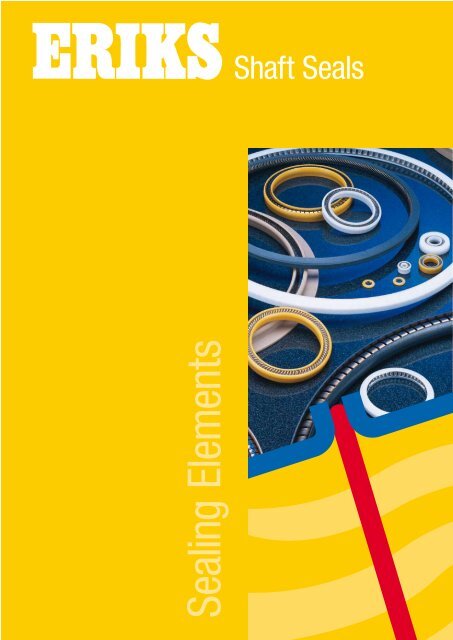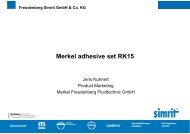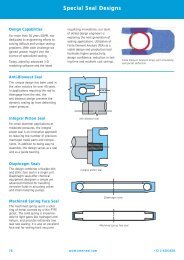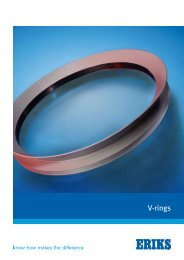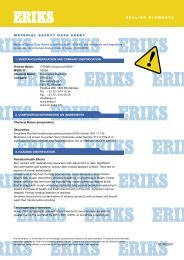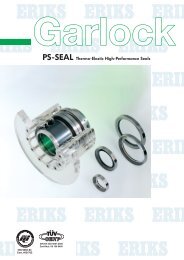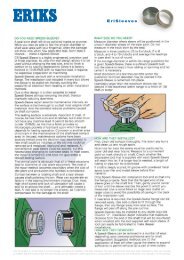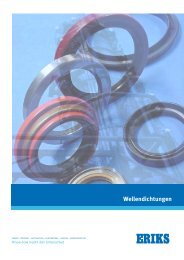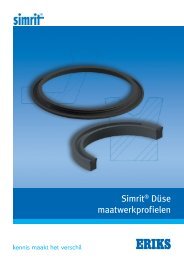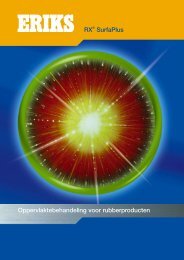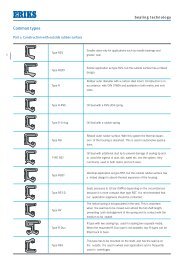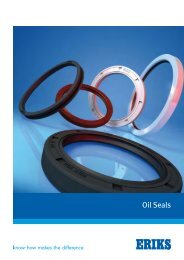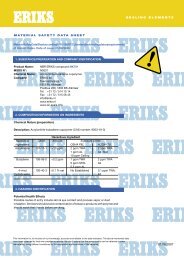VR-Dichtungen (Englisch) (284kB) - Oil-Seals
VR-Dichtungen (Englisch) (284kB) - Oil-Seals
VR-Dichtungen (Englisch) (284kB) - Oil-Seals
You also want an ePaper? Increase the reach of your titles
YUMPU automatically turns print PDFs into web optimized ePapers that Google loves.
S H A F T S E A L S<br />
Shaft <strong>Seals</strong><br />
Sealing Elements<br />
S H A F T S E A L S<br />
C o n t e n t s<br />
Shaft <strong>Seals</strong><br />
1. Technical description...........................................................3<br />
2. Table of properties...............................................................5<br />
3. Lip configurations.................................................................6<br />
4. Materials of the support rings..............................................7<br />
S H A F T S E A L S<br />
1. Te c h n i c a l d e s c r i p t i o n<br />
<strong>VR</strong> Radial lip seals for rotating shafts:<br />
<strong>VR</strong> seals are specially designed to resist higher pressures<br />
than a classic oil seal. They are used with shaft velocities of<br />
maximum 40 m/s.<br />
Advantages:<br />
Secure sealing on unpaved and stainless steel shafts<br />
No traces of damage on the surface<br />
No need for treatment of the shaft surface (coat, temper,<br />
nitrate, …), nor the use of extra sleeves<br />
Thanks to the tangential and radial tension on the lip seal, no<br />
pump effect is provided.<br />
Low friction coefficient, low friction losses<br />
Longer duration of life<br />
The sealing mechanism of <strong>VR</strong> seals<br />
The operating principle of the <strong>VR</strong> radical lip seals without<br />
spring, is that a rubber diaphragm over a steel back-up ring<br />
or a back-up ring made of another material is stretched,<br />
whereby the amount of tension is controlled scrupulously<br />
careful. The sealing lip is placed in a certain angle with respect<br />
to the diaphragm and can both be pointed inwards and<br />
outwards, depending on the direction of the assembly and<br />
the direction where the pressure will work on the seal.<br />
The seal is obtained by the tangential and radial pre-stressed<br />
diaphragm. This provides a tight spring between the membrane<br />
and the lip seal. In addition, the tangential and radial<br />
forces of the lip seal neutralize the tear forces, which arise<br />
as a result of the rotation of the shaft. Vibrations and random<br />
static and dynamic eccentricities are nullified directly in the<br />
surroundings of the locking lips. The partial neutralization of<br />
the lip seal during the rotation of the shaft, and the belonging<br />
pump effect, is seldom occurred with the use of this type of<br />
seal.<br />
Different comparative measurements have proved that<br />
the radial forces, required for a <strong>VR</strong> seal ring, is only 1/3rd<br />
to 1/4th of the radial force compared to the requirements<br />
of a spiral seal with a spring, to become the same sealing<br />
degree. Consequently it is possible to use this type of seal on<br />
unpaved and stainless shafts, without leaving any traces or<br />
grooves on the shaft. Even after 1000 hours of service, there<br />
are only some polish traces perceptible on the shaft.<br />
S H A F T S E A L S<br />
1. Te c h n i c a l d e s c r i p t i o n<br />
<strong>VR</strong>-RWDR<br />
• Radial shaft seal ring with prestretched diaphragm<br />
• Shaft velocity to 40m/s<br />
• Pressure range (vacuum) to 1,5 MPa<br />
• Temperature range: -50°C / +300°C<br />
• Deviation:
S H A F T S E A L S<br />
2 . Ta b l e o f p r o p e r t i e s<br />
Material 75 +-<br />
5° Shore A<br />
Color<br />
Temperature<br />
at the seal<br />
NBR (Nitrile) Black -20°C / +100°C<br />
Properties<br />
NBR (Perbunan)<br />
An acylonitril-butadiene polymer which is excellent<br />
resistant against swelling in solvents based on<br />
aliphatic hydrocarbons, standard benzenes and<br />
mineral oils. The resistance against swelling depends<br />
on the quantity of acrylonitril. Wide temperature<br />
range: 120°C. Resistance against aging; low<br />
reformation under pressure.<br />
Applications: benzene, mineral oil, diluted acid and<br />
alkaline bases.<br />
Not applicable with: aromatics, chloral<br />
hydrocarbons, ketenes, esters and ether and brake<br />
fluids on a glycol base.<br />
FPM Green -30°C / +220°C<br />
FPM (Viton) Fluorocarbon Rubber<br />
Very good resistance against chemicals and<br />
temperatures. Thermal resistance against<br />
temperatures to 250°C.<br />
2<br />
FPM/L Anthracite -30°C / +220°C<br />
Applications: <strong>Oil</strong>s, hydraulic fluids with low<br />
inflammability, fuels (premium benzene), aromatics,<br />
chloral hydrocarbons, concentrated acids and<br />
alkaline bases.<br />
Not applicable with: amines an fluid ammoniac,<br />
ketenes, esters, alcohols with a short chain.<br />
9<br />
FPM/P Peroxide Grey -30°C / +250°C<br />
FPM/T White -30°C / +220°C FDA<br />
VMQ Red -50°C / +300°C FDA<br />
HNBR Peroxide Brown -30°C / +150°C FDA<br />
EPDM Peroxide Blue -40°C / +80°C<br />
FPM-Peroxide<br />
Idem (2), but can also be used in hot steam, hot<br />
water, alcohols and mineral oils. Excellent chemical<br />
resistance.<br />
FPM-PTFE<br />
Idem (2): fluoric rubber, with a PTFE insert. Low<br />
friction coefficient.<br />
VMQ (Silicone Rubber)<br />
Excellent thermal resistance. Can be used in dry heat<br />
to 280°C with long duration of life; stable in mineral<br />
oils to 150°C. Very ozone and oxygen resistant; no<br />
hardness in hypoid lubricants. Applicable for food.<br />
HNBR (Therban/HSN)<br />
Very good resistance against hot water and hot<br />
steam; also oil and high temperature resistant.<br />
Applications: benzene, diesel, oils with many<br />
additives, cooling water, acids and alkaline bases.<br />
Not applicable with: Benzene, mineral oils,<br />
aromatics, chloral hydrocarbons.<br />
EPDM (Ethylene-Propylene)<br />
Very resistant against aging, very strong.<br />
Applications: hot water, hot stem (200°C); ketenes,<br />
esters, acids, hydraulic fluids and brake fluids on a<br />
glycol base. Silicon based lubricants.<br />
Not applicable with: Benzene, mineral oils,<br />
aromatics, chloral hydrocarbons.<br />
NBR-C Anthracite -25°C / 100°C Like (1), (2), (5), with insert of graphite in the basis/ C1<br />
HNBR-C Anthracite -40°C / +150°C<br />
matrix material.<br />
Application: Where lubrication is permitted (water, C2<br />
FPM-C Anthracite -30°C / +220°C<br />
benzene, mineral oils, foods, etc.<br />
Extremely low friction coefficient, low moment loss<br />
thanks to an integrated lubrication.<br />
C3<br />
<strong>VR</strong>.<br />
nr<br />
1<br />
7<br />
8<br />
6<br />
5<br />
3<br />
S H A F T S E A L S<br />
3 . L i p c o n f i g u r a t i o n s<br />
OOA<br />
OOB<br />
DOA<br />
DOB<br />
SOA<br />
Tangential friction force/per meter circumference<br />
(N/m)<br />
300<br />
BSB<br />
260<br />
NBR<br />
FPM<br />
220<br />
HNBR<br />
180<br />
FPM/<br />
PTFE<br />
OAB<br />
140<br />
100<br />
OAC<br />
60<br />
20<br />
0 0,4 0,8 1,2<br />
<strong>Oil</strong> Pressure<br />
MPa<br />
OBC MAC MSC<br />
S H A F T S E A L S<br />
4 . M a t e r i a l s o f t h e s u p p o r t r i n g s<br />
Normal:<br />
• Carbon steel according to DIN 1624<br />
• Stainless steel, material nr 1.4301 (AISI 304)<br />
Special types:<br />
• Aluminum<br />
• Brass<br />
• Stainless steel, material nr 1.4571 (AISI 316Ti)<br />


